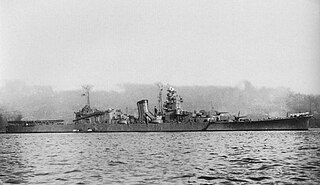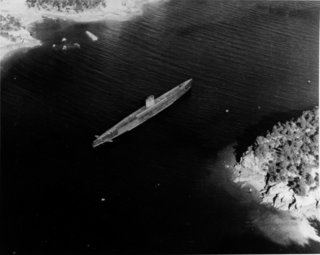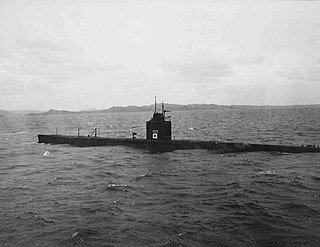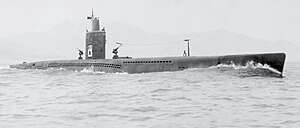
The I-400-class submarine Imperial Japanese Navy (IJN) submarines were the largest submarines of World War II and remained the largest ever built until the construction of nuclear ballistic missile submarines in the 1960s. The IJN called this type of submarine Sentoku type submarine. The type name was shortened to Toku-gata Sensuikan. They were submarine aircraft carriers able to carry three Aichi M6A Seiran aircraft underwater to their destinations. They were designed to surface, launch their planes, then quickly dive again before they were discovered. They also carried torpedoes for close-range combat.

Hyūga was the second and last Ise-class battleship built for the Imperial Japanese Navy (IJN) during the 1910s. Although completed in 1918, she played no role in World War I. Hyūga supported Japanese forces in the early 1920s during the Siberian intervention in the Russian Civil War. In 1923, she assisted survivors of the Great Kantō earthquake. The ship was partially modernised in two stages in 1927–1928 and 1931–1932, during which her forward superstructure was rebuilt in the pagoda mast style. Hyūga was reconstructed in 1934–1936, improvements being made to her armour and propulsion machinery. Afterwards, she played a minor role in the Second Sino-Japanese War.

Ise was the lead ship of her class of two dreadnought battleships built for the Imperial Japanese Navy (IJN) during the 1910s. Although completed in 1917, she played no role in World War I. Ise supported Japanese forces in the early 1920s during the Siberian Intervention in the Russian Civil War. In 1923, she assisted survivors of the Great Kantō earthquake. The ship was partially modernised in two stages in 1928–1929 and 1931–1932, during which her forward superstructure was rebuilt in the pagoda mast style. Ise was reconstructed in 1934–1937, with improvements to her armour and her propulsion machinery. Afterwards she played a minor role in the Second Sino-Japanese War.

The Ise-class battleships were a pair of dreadnought battleships built for the Imperial Japanese Navy (IJN) during World War I. Both ships carried supplies for the survivors of the Great Kantō earthquake in 1923. They were modernized in 1934–1937 with improvements to their armour and machinery and a rebuilt superstructure in the pagoda mast style. Afterwards they played a minor role in the Second Sino-Japanese War.

Ōyodo (大淀) was a light cruiser built for the Imperial Japanese Navy (IJN) during World War II, and was the only ship of her class completed before the end of the war. Designed to command submarine operations, she was obsolete upon completion in 1943. The ship was used as a transport and to escort the navy's capital ships for the rest of the year. Ōyodo was lightly damaged by American aircraft in early January 1944 during one transport mission and returned home several months later to begin conversion to serve as the flagship of the Combined Fleet.

The I-201-class submarines were submarines of the Imperial Japanese Navy during World War II. These submarines were of advanced design, built for high underwater speed, and were known as Sentaka-Dai type submarine or Sentaka type submarine. The type name, was shortened to Suichū Kōsoku Sensuikan Ō-gata.

I-58 was a Japanese B3 type cruiser submarine that served in the final year of World War II. Her only significant wartime success came with a conventional torpedo attack upon USS Indianapolis on 30 July 1945. She was modified to carry Kaiten manned torpedoes, making several attacks that inflicted minor damage in exchange for every Kaiten launched being sunk. The submarine surrendered in September 1945, and was later scuttled by the United States Navy.

Katsuragi (葛城) was the third and final Unryū-class aircraft carrier of the Imperial Japanese Navy built during World War II. Named after Mount Katsuragi, in Nara Prefecture, and completed late in the war; she never embarked her complement of aircraft and spent the war in Japanese waters. The ship was badly damaged in a July 1945 airstrike by American carrier aircraft on Kure Naval Base. Repaired after the end of the war, Katsuragi was then used as a repatriation transport for a number of months, bringing Japanese soldiers and civilians back to Japan from overseas locations. She was scrapped in Japan beginning in late 1946.

Kaiyō was an escort carrier operated by the Imperial Japanese Navy (IJN) during World War II. The ship was originally built as the ocean liner Argentina Maru. She was purchased by the IJN on 9 December 1942, converted into an escort carrier, and renamed Kaiyō. The ship was primarily used as an aircraft transport, escort carrier and training ship during the war. She was badly damaged by repeated air attacks in July 1945 and was scrapped in 1946–48.

I-402 was an Imperial Japanese Navy Sentoku-type submarine commissioned in 1945 for service in World War II. Originally intended to be a submarine aircraft carrier like her sister ships I-400 and I-401, she instead was completed as a submarine tanker, but entered service less than a month before the end of the war and never carried out a tanker voyage. She surrendered to the United States at the end of the war in 1945 and was scuttled in 1946. Until 1965, the Sentaku-type submarines were the largest submarines ever commissioned.

I-201 was the name ship of her class of high-speed submarines built for the Imperial Japanese Navy during World War II. She was commissioned in February 1945, and the war ended before she could carry out an operational patrol. She surrendered to the United States Navy in 1945 and was sunk as a target in 1946.

The attacks on Kure and the Inland Sea by United States and British naval aircraft in late July 1945 sank most of the surviving large warships of the Imperial Japanese Navy (IJN). The United States Third Fleet's attacks on Kure Naval Arsenal and nearby ports on 24, 25, and 28 July sank an aircraft carrier, three battleships, five cruisers, and several smaller warships. During the same period the British Pacific Fleet attacked other targets in the Inland Sea region and sank two escort ships and several smaller vessels as well as damaging an escort carrier.

I-14 was an Imperial Japanese Navy Type AM submarine that served during World War II. Designed as a submarine aircraft carrier, she was commissioned in March 1945. She surrendered in August 1945 and was sunk as a target in 1946.
I-13 was an Imperial Japanese Navy Type AM submarine that served during World War II. Designed as a submarine aircraft carrier, she was commissioned in December 1944 and sunk in July 1945.

I-55, later renumbered I-155, was an Imperial Japanese Navy Kaidai-class cruiser submarine of the KD3A sub-class commissioned in 1927. Early in World War II, she supported Japanese forces in the invasion of Malaya and the Dutch East Indies campaign before assuming training duties in Japan, interrupted briefly in 1943 by her participation in the Aleutian Islands campaign. She became a kaiten manned suicide attack torpedo carrier in 1945 before surrendering at the end of the war. She was scuttled in 1946.

I-54, later I-154, was an Imperial Japanese Navy Kaidai-class cruiser submarine of the KD3A sub-class commissioned in 1927. During World War II, she conducted three war patrols, supporting Japanese forces during the invasion of Malaya in December 1941 and the Dutch East Indies campaign in early 1942, then was assigned to training duties until she was decommissioned in 1944. She was scuttled in 1946.
I-52, later I-152, was the second prototype of the Kaidai-class submarine of the Imperial Japanese Navy. Commissioned in 1925, she became a training ship in 1935 and was decommissioned in 1942 during the early months of the Pacific campaign of World War II. She subsequently served as the stationary training hulk Haikan No. 14 and was scrapped after the war.
Ro-46 was an Imperial Japanese Navy Kaichū type submarine of the K6 sub-class. Completed and commissioned in February 1944, she served in World War II, including operations related to the Marianas campaign, the Philippines campaign, and the Battle of Okinawa. She disappeared in April 1945 during her fifth war patrol.
Ro-49 was an Imperial Japanese Navy Kaichū type submarine of the K6 sub-class. Completed and commissioned in May 1944, she served in World War II and patrolled off the Philippines and the Ryukyu Islands. She was lost during her third war patrol sometime in late March or April 1945.

The Japanese submarine I-203 was an I-201-class high-speed submarine built for the Imperial Japanese Navy during World War II. She was commissioned in May 1945, and the war ended before she could carry out an operational patrol. She surrendered to the United States Navy in 1945 and was sunk as a target in 1946.















